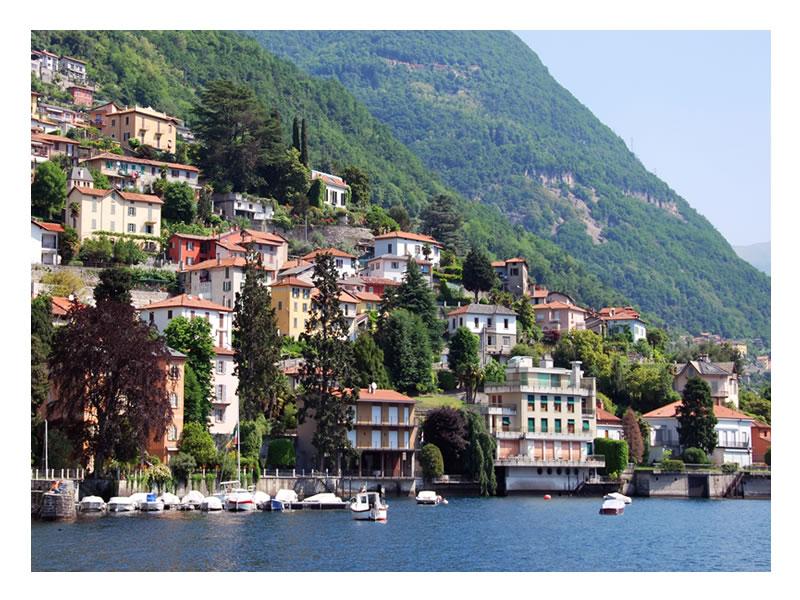 The richest and most developed Italian region, Lombardy, often it seems to have more in common with its northern neighbors, than with the rest of Italy. This is not surprising, when its history is remembered: the French and Austrians ruled here for over two centuries, and the name of the region derives from the West Germanic Lombard people, whose invasion forced the Romans to withdraw. As a border region, to which lead numerous mountain passes, Lombardy has always been exposed to external aggression, but it also benefited from its location at the crossroads of trade routes. It has long been considered the capital of Italy by the people of the North. Emperors from Charlemagne to Napoleon came to Lombardy, to be crowned kings of Italy, and the business moguls from the north of Europe still treat the capital of Lombardy, Milan, more seriously than Rome, because the big companies and banks in this region have economic and political influence all over the country.
The richest and most developed Italian region, Lombardy, often it seems to have more in common with its northern neighbors, than with the rest of Italy. This is not surprising, when its history is remembered: the French and Austrians ruled here for over two centuries, and the name of the region derives from the West Germanic Lombard people, whose invasion forced the Romans to withdraw. As a border region, to which lead numerous mountain passes, Lombardy has always been exposed to external aggression, but it also benefited from its location at the crossroads of trade routes. It has long been considered the capital of Italy by the people of the North. Emperors from Charlemagne to Napoleon came to Lombardy, to be crowned kings of Italy, and the business moguls from the north of Europe still treat the capital of Lombardy, Milan, more seriously than Rome, because the big companies and banks in this region have economic and political influence all over the country.
The price of the region's economic success was the deterioration of the landscape. The industrial hydra suffocates the outskirts of the cities, spreads across the Po valley, and its polluting tentacles extend even to the lakes and mountain valleys to the north. Nevertheless, Lombardy has beautiful surroundings. The upper parts of the valleys are largely untouched by civilization, hiking is possible in the mountains, and the enchanting scenery and lush vegetation of the lake region help to forget, that the water is polluted. In addition, the cities and towns of Lombardy have interesting medieval centers. Lombards, from spoiled snobs from the provinces to labor slaves from Milan, do not show much resemblance to the typical image of an Italian. The inhabitants of this region do not have a good opinion of at least half of their compatriots. They do not consider it appropriate to mention the South at all, they speak of the Romans with irony, and people, which they contemptuously call the terroni (lit. "People of the earth”), tj. immigrants, leaving their poor villages in search of work in the north, are always ready to take advantage of.
The natural gateway to the region is Milan, situated in the central part of the southern Lombardy plain, where most tourists go first. The cities of Pavia on this plain, Cremona and Mantua experienced their heyday during the Middle Ages and the Renaissance, and even though they are surrounded by ever-expanding suburbs, to this day they have retained their historical character. Northern Lombardy is completely different, because there are fewer historical cities among the lakes and mountains (although Bergamo and Brescia are located here). This area, especially around the lakes of Maggiore, How I Garda, it has long been known to tourists, it is also loved by wealthy Lombards, although the candy landscape of lakes advertised by tourist offices, it is unfortunately disrupted by the constant development of industry. Communication in the region is good: main cities, towns and lakes are connected by railroads, and the villages and mountain areas are served by bus companies. Hitchhiking is rarely needed, but in more remote areas, where buses don't run very often, time can be saved in this way.
Most of Lombardy's economic power is concentrated in the cities of the broad Po valley, which forms a kind of belt in the south of the region. This power is visible throughout the region, both in well-preserved medieval towns, as well as in unsightly industrial suburbs. It is also seen in water pollution, especially the dirtiest river in Italy, Padu, and air in Milan, where smog is sometimes so dangerous, that the traffic police must wear gas masks.
Nevertheless, Lombardy is worth visiting. Milan is actually polluted, most of the buildings are modern and have little aesthetic appeal, but there are excellent old and contemporary art galleries here, great cathedral, world-famous expensive and fashionable shops and lively nightlife. As a foretaste of Italy, the city can be a bit baffling, and even disappoint. With time, however, reasoning in contemporary terms, you can start appreciating them. Pavia, situated to the south, is largely medieval and an alternative city, in relation to Milan and calmer, accommodation base. However, the town's cobblestone streets and old churches are definitely overshadowed by Certosy just outside town. To the east is the home of the violin, hometown of Stradivarius, Cremona, which though has nice, well-preserved center, does not encourage a longer stay. Situated at the eastern end of Mantua's region, at least from a distance, the most picturesque city of Lombardy. Tourists are mainly attracted by the remains of the prevailing here 300 years for the Gonzaga family. Their two palaces, the extravagant Palazzo Ducale and located on the edge of the city, boasting some of the most beautiful (and the most erotic) Renaissance frescoes, the later Palazzo Te, are fixed points of the city sightseeing plan.